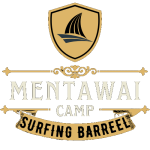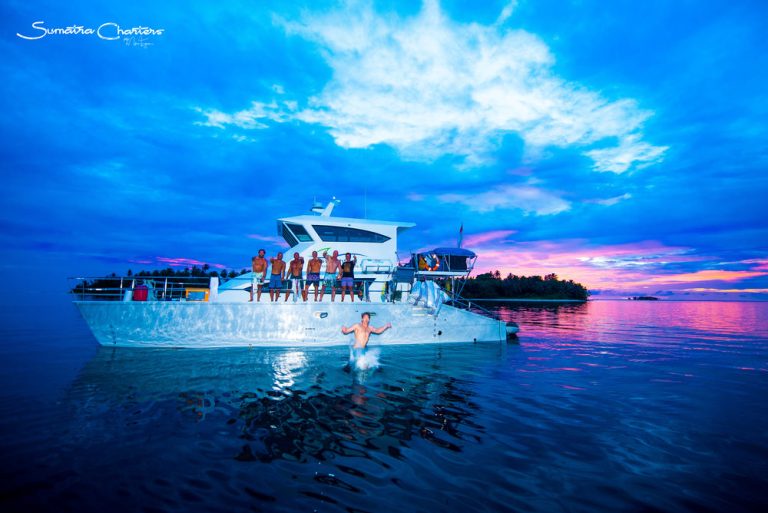Switch Foot Surf Charter Mentawai
Switchfoot is a 52 FT fiberglass, powercat. It was built in Jepara, Java and owned and operated by Sumatra Charters. Switchfoot is specifically designed for luxury surf charters in the Mentawai Islands.
Switchfoot is a high-end charter vessel built with speed (capable of 18 knots), comfort and safety in mind. She is capable of covering great distances and have you surfing as many different waves as possible depending on the prevailing conditions. With a beam of 7.1 meters, there is plenty of space to move around on deck. There is also a spacious air-conditioned saloon/dining area for downtime to relax after a big day of perfect waves and barrels.
To maximize surf time we aim to sail at night (at 10 knots for safety) or we anchor up in a safe calm anchorage close to where we may surf the following morning. We will have you on the break at first light every day. If we decide to surf elsewhere or the conditions change then she is capable of getting you to the next break with speeds of 15- 18 knots depending on conditions.
Overview
• Ample deck space
• Fully air conditioned comfortable sleeping accommodation
• Four cabins with two bunks in each
• Each bunk has a fan and reading light
• Two toilets
• Fully equipped galley leading onto our deck bar/eatery
• A large seated dining area
• Flat screen TV and a hard drive with an extensive range of movies
• Bluetooth stereo system
• Library with board games
• Fishing gear Snorkeling gear Full medical kit
Specs
• Switchfoot: Indonesian flagged
• Length OA: 15.8 Metres
• Beam: 7.1 Metres
• Draft: 0.66 Metres Fuel
• Capacity: 2 x 2100 Litres F/W
• Capacity: 2 x 620 Litres
• Lightship Weight: 13 Tonnes
• Construction: Fiberglass
• Hull Type: Symmetrical Hard Chine
• Main Engines: YANMAR 6LPA-STP2 315Hp @ 3800/rpm
• Transmissions: KMH50A Ratio 1.67
• Max Speed: 18 Knots
• Cruise Speed: 12 Knots
• Genset:2x VETUS 14 Kva
• Watermaker: 120 Litres p/hour
• Steering: Hydrive Power Assisted
• Controls: TELEFLEX KE4+ Electronic 2 tenders Electronics, Navigation & Communication Equipment GPS Chart Plotter: 2 x LOWRANCE 12” HDS
• Radar: LOWRANCE 4G Radar 36nm
• Sounder: LOWRANCE Elite 7 x HDI
• Autopilot: CORSEMASTER
• Compass: PLASIMO
• VHF Radio: ICOM IC-M504A
• HF Radio ICOM
• AIS ICOM MA-500 TR
• Fuel Management system MARETRON
• Sat phone / EPIRB
• All required safety / Life raft equipment 2 tenders. 3.5 mtr rubber zodiac 15hp / 4.6 mtr aluminium centre consol tinne 60hp
Surf
The Mentawai Islands lie roughly 100 km off of the west coast of Sumatra in Indonesia. They consist of 4 main islands with many smaller islands scattered throughout. From north to south, the main islands are Siberut, Sipora, North Pagi, and South Pagi. These islands block most swells from reaching the mainland on Sumatra, but they offer some of the most perfect surf in the world. Access to the islands is by sea only with regular ferries to the main trading ports, but by far the best way to access the surf is by charter boat.
From up north to down south the following is a list of better known spots from which to choose (leaving out some semi-secret and un-named spots):
• Ebay – A perfect barreling left that needs a bit more swell. Very scenic.
• Kandui – A very fast, challenging, barreling lefthander that breaks from 3 – 12 feet, but is Triple Black Diamond over six feet.
• Nokandui – A long, hollow freight-train left hander, that needs size and perfect conditions to be makeable.
• 4 Bobs – Short right well protected from most winds, shallow reef.
• Bank Vaults – Right hander that can be a little shifty, but serves up backdoor barrels. Very heavy board snapping power with size.
• Nipussi – A very consistent short fun easy right.
• Scarecrows – Just another world-class lefthander that will satisfy your wildest dreams – and occasionally match your worst nightmares.
• Telescopes – A long, beautiful lefthand reef pass that is out to sea and exposed, so prone to the wind. A spectacular wave.
• Lance’s Left – Quality fun long left, very consistent, best with southeast wind. Can be a series of lefts if you want to push further up the reef.
• Lance’s Right (HT’s) – One of the best right hand barrels in the Mentawai with a couple take off zones. Best with no wind or Northwest wind. Be careful of the “Surgeons Table” and inside area of shallow sharp reef.
• Macaronis – Voted the best wave in the world by Tracks Magazine and “funnest wave” by Waves Magazine, this left hander is the star of countless surf videos. A hollow but manageable take off followed by a long wall that is often workable, or hollow. Makes the average surfer feel like a super star!
• Rifles – One of the best rights in Indonesia, a long hollow wall with multiple tube sections. To make the length of the wave you must commit to riding the tube, likes the south swell and light northwest winds.
• Thunders – A swell magnet and “go to” spot when the swell is small. This can be a fun long walled left with multiple tube sections, but when big provides a “Sunset” like drop that sometimes gets a bit fat and shoulders off down the line.
• Rags Left – A long barreling wave that turns on during large southwest swells and has been surfed up to 15 feet.
• Rags Right – This wave has been described as “a formidable opponent to your health, safety, and well-being.” Low tide is out of the question, but on a high tide and the proper swell, this is one of the thickest, hollowest tubes in the Mentawai’s.
• The Hole – A fast hollow left with quick take off and hollow end section. Ends in very shallow water, better for advanced surfers.
Seasons & Weather
The Mentawai are in western Indonesia, just below the equator, so these islands are generally wetter and more lush than Bali and the islands further southeast.
The Indonesian archipelago stretches along the equator between the hot, dry Australian land mass to the south, and the hot, wet Asian land mass to the north. Indonesia’s climate is tropical and in the Mentawai there is little difference in the length of a day year around; but because of those land masses lurking above and below, Indonesia’s seasons divide in two: wet and dry.
The wet season begins in October and lasts until March, with the peak rainfall measured January and February, when high pressure flowing south from the Asian mainland combines with humid air from the Indian Ocean to bring rain throughout the archipelago – although the northern and western islands get more rain than those in the south and east.
March/April is the beginning of dry season, when high pressure over Australia pushes air north to blanket Indonesia with warm, dry air. The dry season peaks June through August, which is also in the heart of surf season.
Prime season for swell in Indonesia is the southern hemisphere winter – March/April through September/October – when low pressure systems off Antarctica and the Indian Ocean pulse ground swells toward the equator. These ground swells travel for thousands of miles, allowing them time to “unwrap,” organize and march onto the reefs of Indonesia as perfectly groomed lines.
Winds are also a factor to be considered. May through Aug/Sept typically sees easterly trades which are favorable for many of the main breaks. November through February generally sees northwesterly winds, which may not be favorable for the big name breaks, but there are waves that favor this wind direction. The shoulder or transition months of March/April and September/October will experience light and variable winds due to the changing of seasons. These months often experience glassy conditions and can be the best time to sample a larger variety of waves.
Although most of the rain falls during the wet season, rainstorms can occur at any time of year. Air temperatures range between 75° and 85° year around and water temperatures are always in that same range.
So, when is the best time? Like with so many questions the answer is: “It depends.” It depends on your desires. If you want big surf with favorable trades, May to September is probably best. If you want to experience some glassy conditions and get a few more rights and less people (but possibly sacrifice some swell size) March/April or late Sept/Oct is probably best. If you don’t mind rain but good surface conditions and smaller, clean surf with nobody else around: give the off season a try, from November to February.


